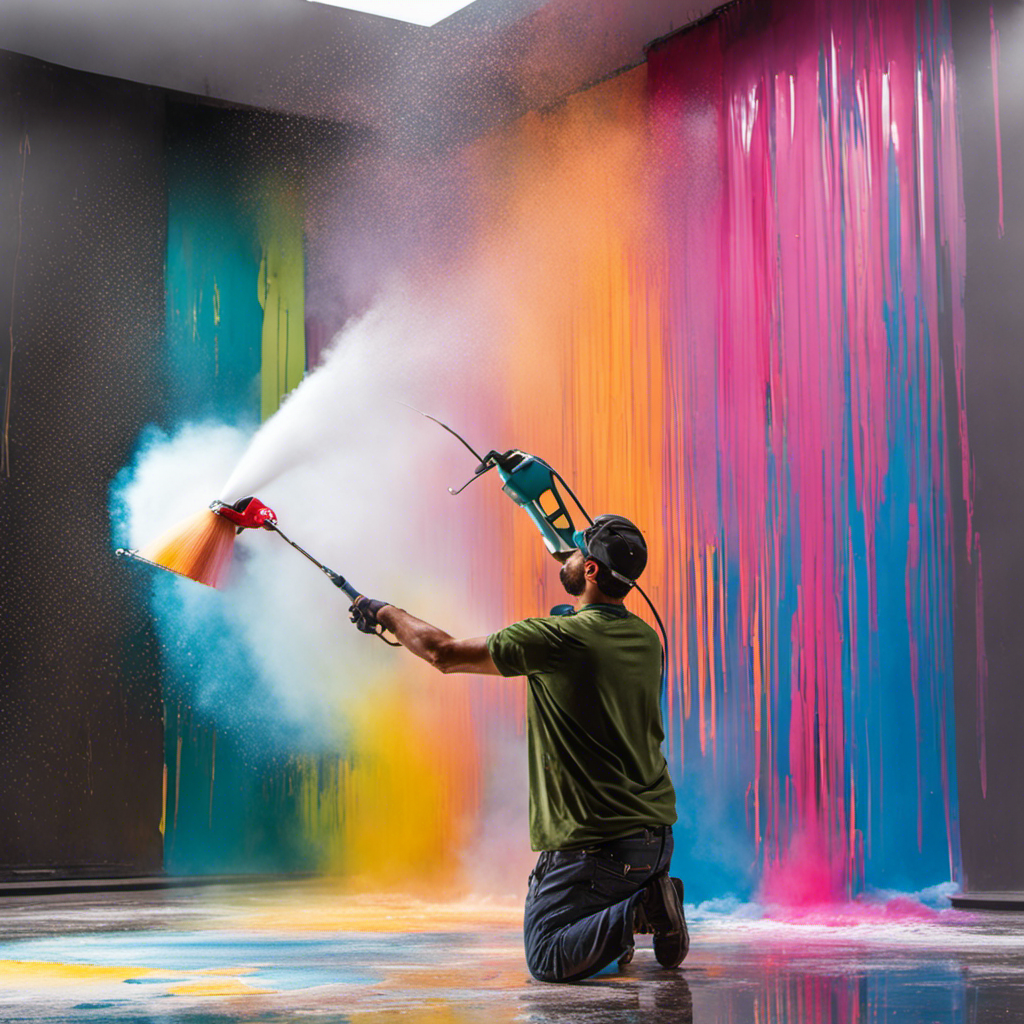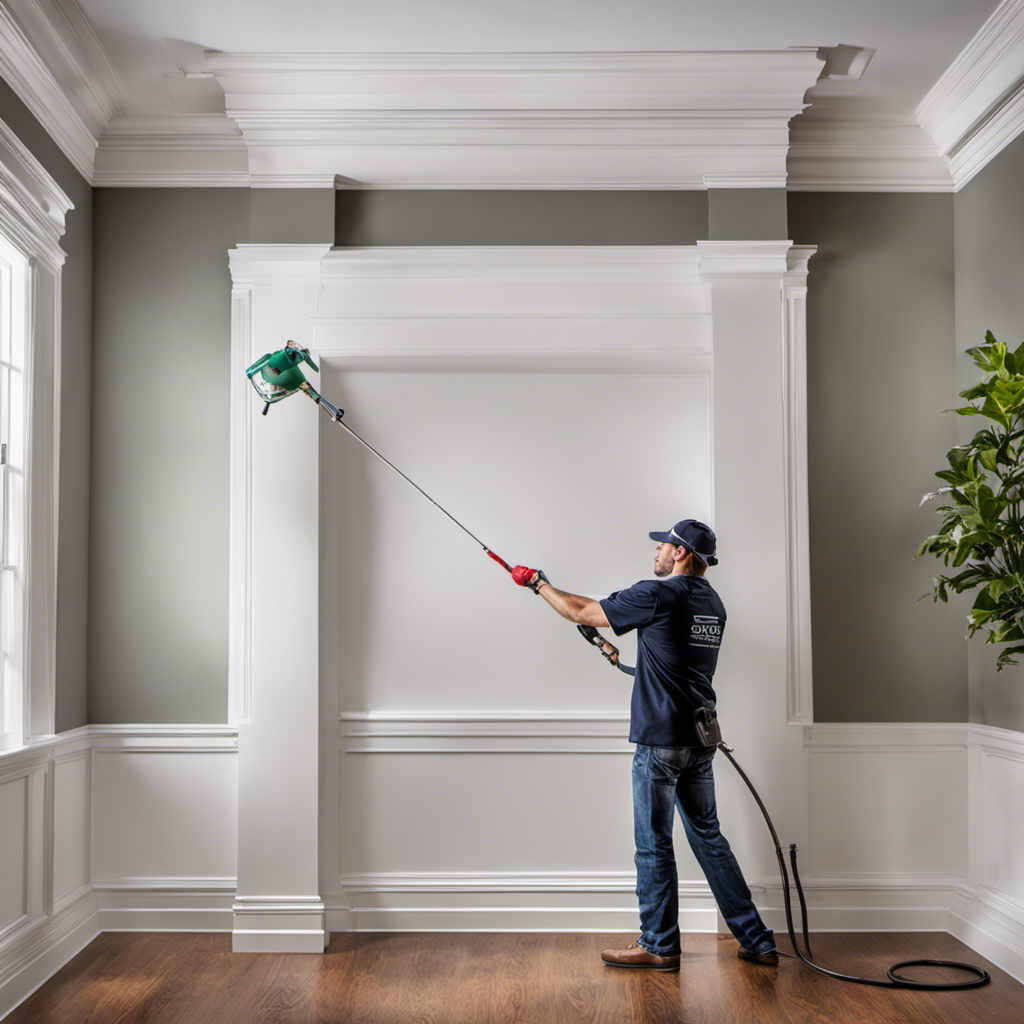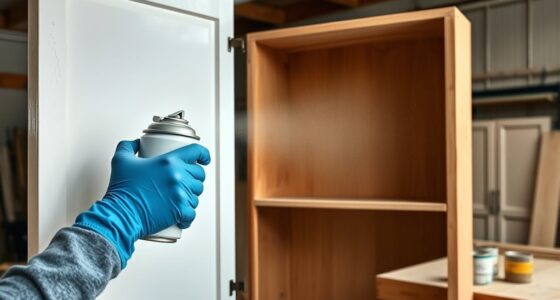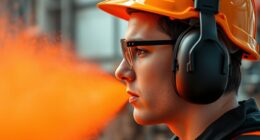In the piece entitled ‘Mastering Airless Sprayer Painting,’ the writers provide a comprehensive guide for achieving professional-level results with an airless paint sprayer.
They emphasize the importance of proper preparation, including clearing clutter and protecting surrounding areas.
With a focus on wearing protective clothing and working in a well-ventilated space, they advise on choosing the right paint and adjusting the sprayer for optimal results.
By highlighting proper spraying techniques and maintenance tips, readers are equipped to troubleshoot common issues and achieve flawless finishes.
Key Takeaways
- Proper spray tip selection is crucial for achieving desired results and troubleshooting issues
- Using the correct pressure for different paints and surfaces ensures optimal paint application and coverage
- Following proper spraying technique, including maintaining consistent spraying distance and angle, results in a professional-quality finish
- Maintaining a smooth and even arm movement, overlapping each pass of the sprayer, and adjusting the speed of arm movement based on desired paint coverage are important for achieving thorough and consistent paint coverage.
Preparing for Painting
The painter clears clutter and protects surrounding areas before starting to paint. This is an essential step in preparing the workspace for painting. By removing any items that could get in the way or be damaged during the painting process, the painter ensures a clean and organized area to work in.
Additionally, protecting surrounding areas such as floors, furniture, and fixtures with drop cloths or plastic sheets prevents accidental spills or splatters from damaging these surfaces.
Another important aspect of preparing for painting is choosing the right paint color. The painter should consider factors such as the desired aesthetic, lighting conditions, and the existing color scheme of the space. By carefully selecting the paint color, the painter can create a cohesive and visually pleasing result.
Clearing Clutter and Protecting Surrounding Areas
To clear clutter and protect surrounding areas, one should wear protective clothing and ensure proper ventilation. This is essential to prevent any potential damage to the surfaces and to keep oneself safe from harmful fumes and particles. In addition, it is important to take the necessary precautions to protect the floor, furniture, and other items in the vicinity of the painting area. Using drop cloths or plastic sheets can help in preventing any accidental spills or splatters. Moreover, covering furniture and removing any fragile or valuable items from the area will further safeguard them from any potential damage. By taking these simple steps, one can ensure a clean and protected environment for painting, allowing for a smooth and hassle-free process.
| Clearing Clutter | Protecting Surfaces |
|---|---|
| Wear protective clothing | Use drop cloths or plastic sheets |
| Ensure proper ventilation | Cover furniture and remove fragile items |
| Remove unnecessary items | Protect flooring with protective covers |
| Organize tools and equipment | Safeguard valuable items from potential damage |
Wearing Protective Clothing and Ensuring Proper Ventilation
Wearing protective clothing and ensuring proper ventilation is crucial for the safety of the painter and the quality of the paint job.
When painting, it is important to choose the right protective clothing to safeguard against potential hazards. This includes wearing coveralls or a paint suit, gloves, safety glasses or goggles, and a respirator or mask. These items provide protection against paint splatters, chemicals, and fumes.
Proper ventilation is also essential to maintain a healthy working environment. Opening windows and doors, using fans, or employing exhaust systems can help to remove airborne particles and fumes. Adequate ventilation helps to prevent the buildup of harmful toxins and improves air quality for both the painter and anyone else in the vicinity.
Gathering Necessary Materials and Setting Up Workspace
When gathering necessary materials and setting up the workspace, painters should ensure they have all the tools and equipment they need for a successful paint job. This includes paint brushes, rollers, drop cloths, painter’s tape, and a paint tray.
It is also important to have proper ventilation in the workspace to ensure the safety of the painter. This can be achieved by opening windows or using fans to circulate fresh air.
Additionally, painters should remove any obstacles or clutter from the area to create a clean and organized workspace.
Choosing the Right Paint and Thinning It if Necessary
A painter must carefully select the appropriate paint for the job and may need to thin it if necessary to achieve the desired consistency.
Choosing the right paint for different surfaces is crucial for a successful painting project. Different surfaces require different types of paint, such as latex or oil-based, depending on their characteristics. It is important to consider factors such as durability, adhesion, and resistance to moisture or chemicals when selecting paint.
Additionally, thinning the paint can help achieve optimal spraying results. Thinning paint allows for a smoother application and better coverage. It is important to follow the manufacturer’s instructions for the specific type of paint being used and to use the appropriate thinner to achieve the desired consistency.
Preparing the Surface for Painting
To prepare the surface for painting, the painter must thoroughly clean it to remove any dirt, dust, or grease. This step is crucial to ensure proper adhesion of the paint and a smooth finish. Here are five key steps for surface preparation:
- Clear any clutter and protect surrounding areas to prevent any accidental damage during the painting process.
- Wear protective clothing and ensure proper ventilation to protect yourself from any harmful fumes or particles.
- Gather all the necessary materials and set up your workspace to make the painting process more efficient.
- Choose the right paint for your project and thin it if necessary, following the manufacturer’s instructions.
- Finally, clean the surface thoroughly, removing any dirt, dust, or grease using appropriate cleaning agents or solutions.
Properly preparing the surface will ensure a professional-quality finish and help the paint adhere better, resulting in a longer-lasting and more attractive paint job.
Setting Up and Adjusting the Airless Sprayer
The painter adjusts the airless sprayer by setting the spray pattern, pressure, nozzle width, and direction. To achieve the desired results, it is crucial to adjust the pressure according to the type of paint being used. Thicker paints and larger surfaces require higher pressure, while thinner paints and smaller areas need lower pressure.
By doing so, the painter ensures an even and consistent application of paint. Additionally, troubleshooting common issues with the airless sprayer is essential. Clogged spray tips and inconsistent spray patterns are common problems that can be addressed by mixing and straining the paint, choosing the right spray tip, and applying multiple thin coats.
Following these steps will help the painter achieve a professional-quality finish.
Adjusting Spray Pattern, Pressure, Nozzle Width, and Direction
Adjusting the spray pattern, pressure, nozzle width, and direction is crucial for achieving an even and consistent application of paint. The spray pattern determines how the paint is distributed, while the pressure affects the force at which the paint is sprayed.
Nozzle width and direction determine the coverage area and how the paint is applied to the surface. To achieve the desired results, proper spray tip selection is essential. Different spray tips have different characteristics and are suitable for different types of paint and surfaces.
It is also important to troubleshoot any issues that may arise during the painting process. By following troubleshooting techniques, such as clearing clogged spray tips or addressing inconsistent spray patterns, one can ensure a professional-quality finish.
Using the Correct Pressure for Different Paints and Surfaces
Using the correct pressure for different paints and surfaces ensures optimal paint application and coverage. It is important to choose the appropriate nozzle size for different paints and surfaces to achieve the desired results. Understanding the impact of pressure on paint application quality is crucial in achieving a professional finish.
When using an airless sprayer, adjusting the pressure is essential. Higher pressure is typically used for thicker paints and larger surfaces, while lower pressure is suitable for thinner paints and smaller areas. By adjusting the pressure accordingly, you can avoid issues such as overspray or uneven coverage.
To assist you further, here is a table showing the recommended pressure range for different paint types and surfaces:
| Paint Type | Surface | Pressure Range |
|---|---|---|
| Latex | Walls, ceilings | 2000-2500 PSI |
| Oil-based | Wood, metal | 2500-3000 PSI |
| Stains, sealers | Decks, fences | 1500-2000 PSI |
Proper Spraying Technique
To achieve a professional finish, painters should maintain a consistent spraying distance and angle to ensure even paint coverage. This proper spraying technique is crucial in achieving a smooth finish and avoiding common mistakes.
Here are some key tips to keep in mind:
- Maintain a consistent spraying distance and perpendicular angle to the surface.
- Move the arm smoothly and evenly in a sweeping motion, overlapping each pass.
- Avoid spraying too close or too far, applying too much pressure, and moving too quickly.
By following these guidelines, painters can achieve a smooth and even paint coverage, enhancing the color depth and improving durability. It is important to remember that proper spraying technique is essential in achieving a professional-quality finish.
Maintaining Consistent Spraying Distance and Perpendicular Angle
The painter maintains a consistent spraying distance and perpendicular angle to the surface, ensuring even coverage and a professional finish. By doing so, they prevent overspray and achieve optimal paint distribution. This technique is essential for achieving a flawless result and improving the overall spraying technique.
In addition, maintaining a consistent spraying distance and perpendicular angle helps troubleshoot common issues with spray patterns. It allows the painter to identify and correct any inconsistencies or irregularities in the paint application. By paying attention to these details, the painter can easily adjust their technique and achieve better control over the spray pattern.
This improvement leads to a smoother and more uniform finish, enhancing the overall quality of the paint job.
Moving Arm Smoothly and Evenly in a Sweeping Motion
With practiced precision, the painter smoothly and evenly moves their arm in a sweeping motion, ensuring thorough and consistent paint coverage. This sweeping motion technique is crucial for achieving a professional-quality finish when using an airless sprayer.
Here are some arm movement tips to master this technique:
- Maintain a steady and fluid motion throughout the entire painting process.
- Keep the arm at a comfortable angle, neither too high nor too low.
- Overlap each pass of the sprayer to avoid missed spots.
- Adjust the speed of the arm movement based on the desired paint coverage.
- Practice control and coordination to avoid excessive paint buildup or streaks.
Frequently Asked Questions
How Do I Troubleshoot and Fix Clogged Spray Tips?
To troubleshoot and fix clogged spray tips, the first step is to remove the tip from the sprayer.
Next, use a small brush or toothpick to carefully remove any paint or debris that may be blocking the tip.
If the clog persists, soak the tip in a cleaning solution or warm water for a few minutes, then use the brush or toothpick again to clean it.
Rinse the tip thoroughly before reattaching it to the sprayer.
What Are Some Tips for Achieving a Professional-Quality Finish?
To achieve a professional-quality finish, it’s important to focus on achieving a smooth and even coat of paint.
One tip is to choose the right nozzle for the job. This will ensure that the paint is applied evenly and without any streaks or inconsistencies.
Additionally, using a sweeping motion and overlapping each pass will help achieve a flawless result.
How Do I Properly Mix and Strain Paint Before Using It in the Airless Sprayer?
Proper paint mixing and straining techniques are essential before using an airless sprayer. To achieve a professional-quality finish, start by thoroughly stirring the paint to ensure it’s well-mixed.
Then, strain the paint through a mesh strainer to remove any lumps, debris, or impurities. This step helps prevent clogging in the sprayer and ensures a smooth application.
What Are Some Common Issues That Can Occur When Using an Airless Sprayer and How Do I Address Them?
Common issues that can occur when using an airless sprayer include clogged spray tips and inconsistent spray patterns. To address these issues, it is important to regularly clean the sprayer and flush it with water or cleaning solution.
Paying attention to the nozzle, filters, and hoses, and removing stubborn paint particles can help prevent clogs. Additionally, troubleshooting techniques such as adjusting the spray pattern, pressure, and direction can help achieve a consistent and professional-quality finish.
Can I Use an Airless Sprayer for Painting Small Areas or Do I Need a Different Tool?
An airless sprayer can be used for painting small areas, eliminating the need for a traditional brush. Using an airless sprayer offers several benefits for small painting projects. It allows for faster and more efficient coverage, ensuring a smooth and even finish.
The sprayer also minimizes overspray, resulting in less wasted paint. Additionally, it can reach tight corners and crevices that may be difficult to access with a brush.
Overall, an airless sprayer is a convenient and effective tool for painting small areas.
Conclusion
In conclusion, mastering airless sprayer painting requires careful preparation, proper setup, and adjustment of the sprayer, and the use of correct spraying techniques.
It is essential to clear clutter and protect surrounding areas, wear protective clothing, and work in a well-ventilated space.
Choosing the right paint and adjusting the pressure according to the paint type and surface size is crucial.
By maintaining a consistent spraying distance and angle, moving the arm smoothly, and avoiding common mistakes, a professional-quality finish can be achieved.
One interesting statistic is that using an airless sprayer can save up to 50% of painting time compared to traditional methods.
Franz came aboard the Paint Sprayer Zone team with a background in both journalism and home renovation. His articulate writing style, combined with a passion for DIY projects, makes him an invaluable asset. Franz has a knack for breaking down technical jargon into easy-to-understand content, ensuring that even the most novice of readers can grasp the complexities of paint sprayers.










